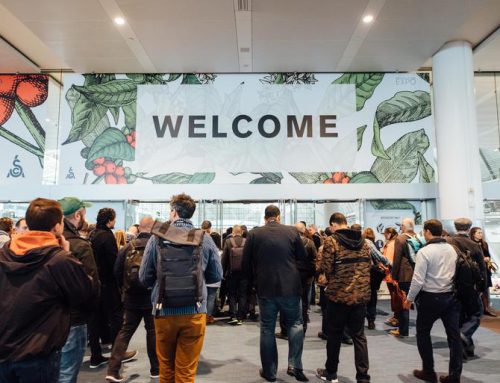Over half a million families dedicate their livelihoods to producing unroasted Colombia green coffee on small farms that dot the country’s volcanic mountain ranges. As the world’s third-largest producing country, the volume, quality, and variety that comes out of Colombia year-round is staggering. Coffee from Colombia is never dull, and we look forward to every harvest with eager anticipation.

Colombian coffee farmer drying green coffee in solar dryer
History of Coffee in Colombia
Coffee arrived in Colombia by way of Jesuit priests as early as 1790 but it didn’t become a major industry until the 19th century. The first commercial production of 60kg bags was recorded in 1808 and exported out of the country via the port of Cucuta. Years of war and foreign debt crisis left large coffee estates in disrepair. The industry stalled until the formation of the National Federation of Coffee Growers (FNC) in 1927.
What began as an export institution became an instrumental contributor to the rise of Colombia’s coffee industry. The FNC’s priority was to raise the image of Colombian coffee beans. This effort led to the “Juan Valdez” marketing campaign in 1958. The campaign distinguished 100% Colombian coffee from traditional South American coffee blends (…before single origin coffee was cool).
Today, the FNC also manages the national coffee fund bankrolled by a tax paid by producers. The money goes towards technical assistance and research at the renowned Cenicafé center. Some notable achievements have been developing varietals with rust resistance and improvements in picking practices. With the FNC’s role as both a coffee institute and an exporter, producers and green coffee companies work closely with the FNC on all their exports.
Coffee Production in Colombia
With 16 coffee-producing regions along three mountain ranges and two harvests each year – the main one and the mitaca – Colombia always has fresh coffee on hand. The South American origin also has access to both the Atlantic and Pacific Oceans, which is a unique blessing for shipping logistics. The country’s geographic location, just on the edge of the intercontinental wind, is also a huge advantage for coffee farming. Beneficial rain patterns form a variety of micro-climates that nurture Colombia’s coffee year-round.
It’s nearly impossible to generalize Colombian coffee because there is so much variety across regions. Even within regions, roasters can find numerous micro-climates that display unique characteristics in the cup. Higher temperatures and lower altitudes toward the north produce fuller bodies and less acidity; the central region, where the bulk of the coffee is grown, is softer and sweeter and more often used to balance out blends; meanwhile, in the south, high altitude farms bring out the complexity and floral notes in Colombian crops.
The biodiversity there is incredible; in fact, it’s the second most diverse country in the world. Colombia’s biological richness in each region really lends itself to the wide variety of coffee being produced, and the result blooms in the complexity found in each cup. A substantial volume of the world’s Arabica coffee is harvested and exported every month, and while Colombia is known for some of the finest washed coffees on Earth, new processing methods are being explored as producers develop their understanding of biochemistry in the beans.
Many farms are small, averaging about 1.5 hectares. Around 540,000 families farm coffee, and out of the 840,000 hectares of coffee farmland, about 685,000 are populated with younger trees between three and seven years old. These young crops are primarily new and improved varietals grown using modern techniques.
Much of the wet milling in Colombia is done at the farm level, and procurement is mostly done in dry parchment. This, in turn, impacts quality at the farm level because green coffee buyers like Genuine Origin can assist and co-administrate with the field team via our local sister company, Carcafe, to help everyone achieve a clean cup.
The United States imports around 40% of Colombia’s total green coffee output. On average, Colombia produces around 13 million 60kg bags of Arabica green coffee per year. However, recent challenges in rising production costs and adverse weather patterns have caused yields to drop to 11 million bags. For 2023/2024, the USDA forecasts a coffee volume of 11.6 million bags, improving slightly as a result of more favorable weather conditions.
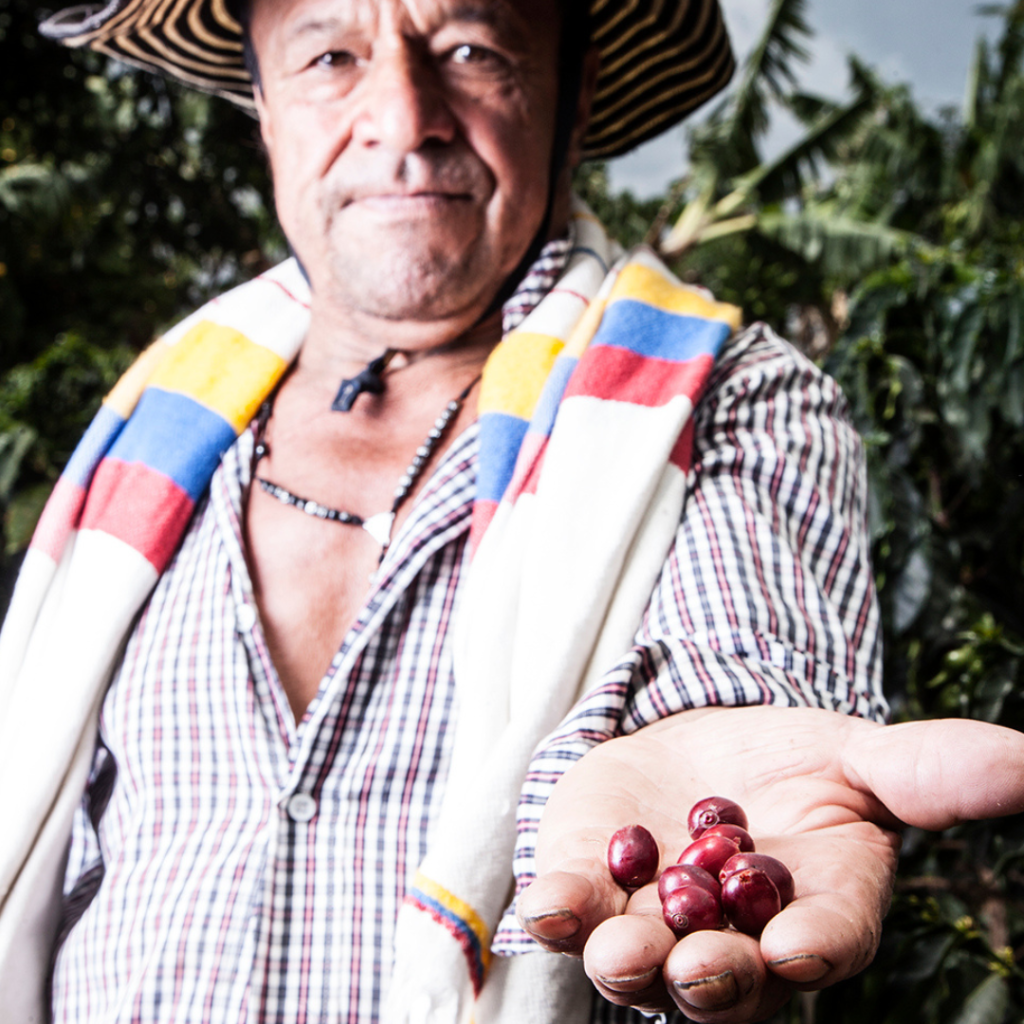
Colombian coffee farmer with ripe red coffee cherries
Common Colombia Green Coffee Varietals
Colombia is one of the few coffee origins that almost exclusively grows Arabica coffee. That’s because the high altitudes of the Andes mountains are so well-suited for quality Arabica cultivation. The most common varietals are Typica, Bourbon, Caturra, and Maragogipe, with three rust-resistant Cenicafé-developed strains – Tabi (Typica x Bourbon x Timor hybrid), Colombia (Caturra x Timor hybrid), and Castillo (also Caturra x Timor hybrid) – that are usually found on Colombian coffee farms. Gesha coffee also thrives in Colombia, particularly in the south, where coffee grows closer to the equator at soaring altitudes.
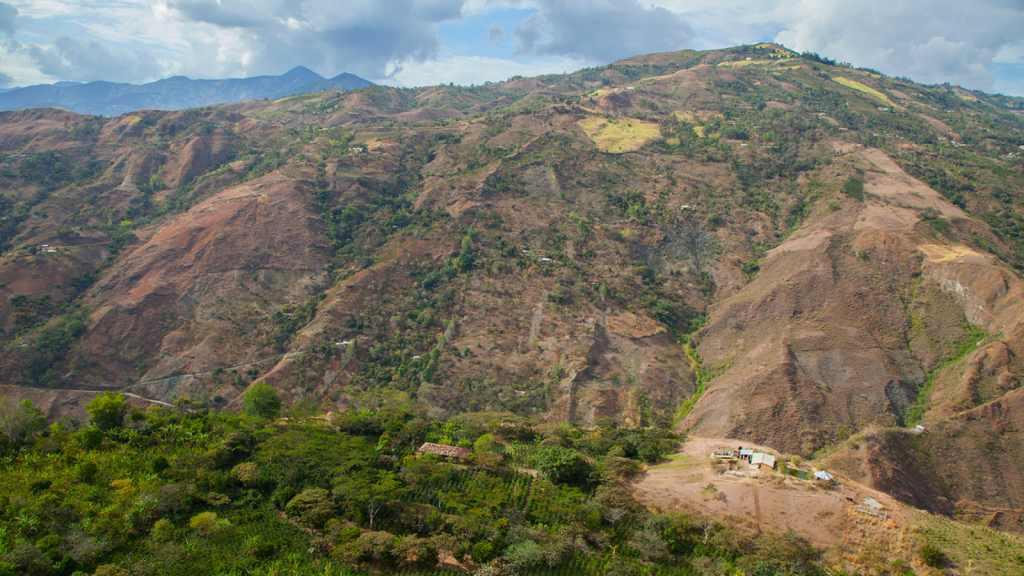
Colombia Green Coffee Producing Regions
The Eje Cafetero Coffee Axis was where most of Colombia’s coffee once came from. That area is part of the UNESCO World Heritage list, and different forms of traditional coffee-growing practices are preserved there. This is where you can also visit the Colombian National Coffee Park theme park. Now, Colombia’s coffee-growing regions can be grouped into four main areas: North, Central, East, and South.
The Santander, Magdalena, Guajira, and Cesar Departments comprise the North. The distinct wet and dry seasons there encourage timely flowering and a predictable harvest in October and November. These areas have lower altitudes and higher temperatures, which translates to coffee with less acidity but more body.
The Central region includes the Central North and Central South zones, which encompass South of Antioquia, Boyacá, Caldas, Chocó, Risaralda, Quindío, North of Valle del Cauca, Cundinamarca, and North of Tolima. Antioquia and Tolima are two of the biggest coffee-producing areas of Colombia, making this region a heavyweight for the country’s coffee volume. With two dry seasons and two wet seasons every year, coffee is harvested twice – once in May and June and again from October to December.
In the East, the coffee-growing area is much smaller, with around 5-6,000 producers working on 10,000 hectares of land. The departments here include Arauca, Casanare, Meta, and Caquetá, and while they share similar characteristics as the North, the East experiences more rainfall and humidity throughout the year. A lot of effort is being put into the East to improve coffee productivity.
The South is chiefly associated with high-altitude and high-quality Colombian green coffee. That’s because Cauca, Huila, and Nariño are closer to the equator and rich with volcanic soil on the slopes of the Andes mountains. Coffee from Huila is a Denomination of Origin region with a signature profile of fruit and caramel notes, sweet acidity, and intense aromas. There is also only one wet and dry season, but the harvest occurs between April and June instead of in the fall.
Most Colombian green coffee grows at altitudes between 1,200-1,800masl, but some areas can reach as high as 2,300masl. With so many harvest seasons in the different producing regions, Colombia always offers fresh coffee year-round.
Colombia Green Coffee Quality Specifications
The Colombia Coffee Federation classifies green coffee quality by screen size and by the number of defects present in a sample. Green coffee is considered specialty if it scores above 80 points, has zero primary defects, and has no more than five secondary defects in a 500g sample.
Primary defects include full black, full sour, dried cherry/pod, fungus damage, foreign matter, or severe insect damage. Secondary defects include partial black, partial sour, parchment, floaters, immature/unripe, withered, shell, broken/chipped/cut, hull/husk, and slight insect damage.
The International Coffee Organization (ICO) maintains the following screen size classifications for Colombian coffee:
- Premium: Screen size 18 with tolerance for 5% at screen 14
- Supremo: Screen size 17 with tolerance for 5% at screen 14
- Extra: Screen size 16 with tolerance for 5% at screen 14
- Excelso: Screen size 14 with tolerance for 1.5% at screen 12. At least 50% must be screen 15
- Caracol: Screen size 12 with tolerance for up to 10% of flat beans
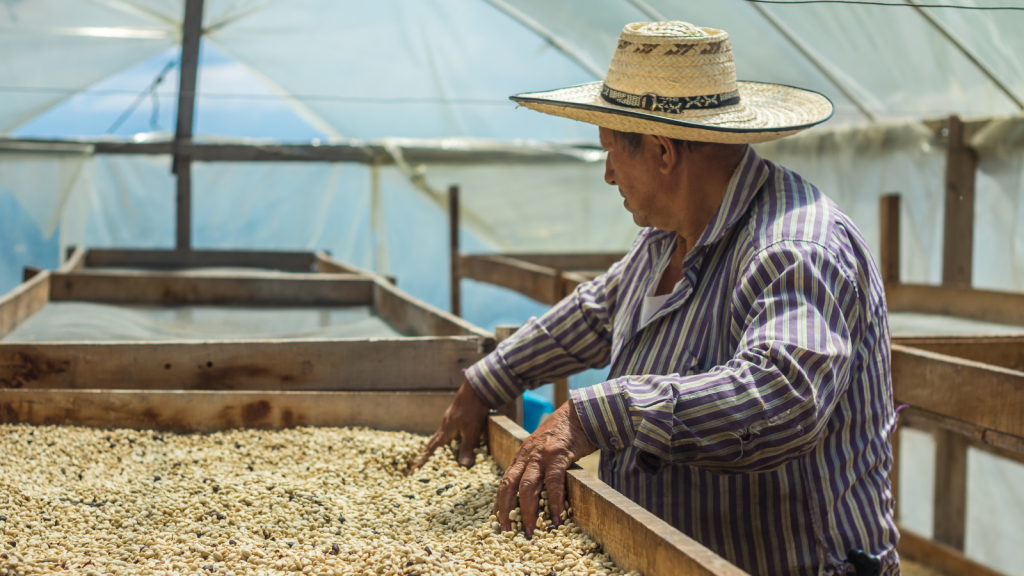
Colombian coffee farmer with microlots in solar dryer
What does Colombian coffee taste like?
You can usually expect a well-balanced flavor experience from a cup of Colombian coffee. With pronounced aroma, pleasant acidity, medium-high body, and clean finish, Colombian coffee offers a high-quality, crowd-pleasing, and reliable cup profile. You can’t go wrong with coffee from Colombia. It just doesn’t disappoint.
Of course, the higher you go, the more acidity, aroma, and flavor you get. That’s why regions like Nariño, that straddle the equator, are known for intense acidity and aroma.
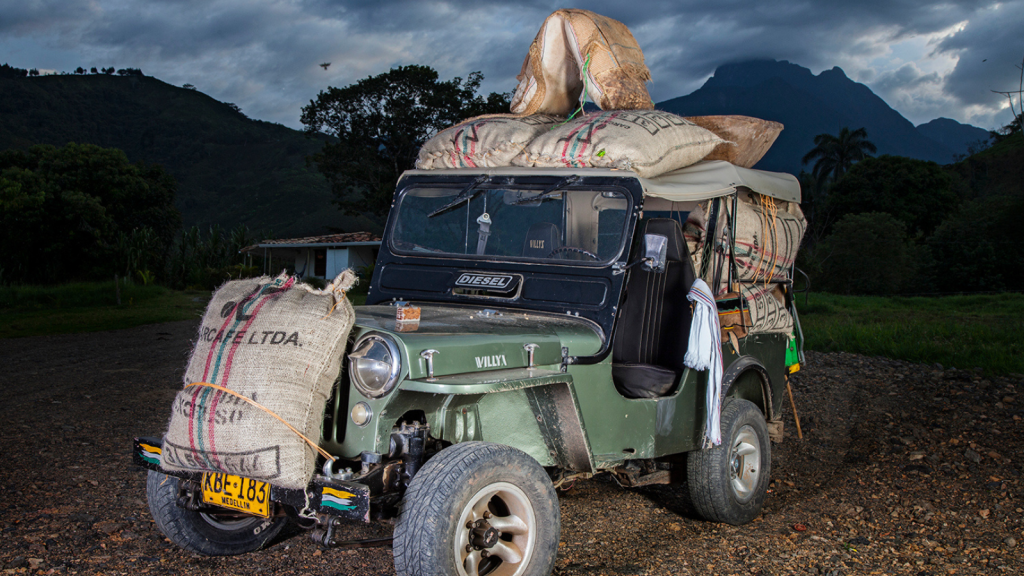
A jeep in Colombia used to transport bags of Colombian coffee
Genuine Origin in Colombia
Carcafe, Genuine Origin’s sister company and sourcing partner in Colombia, is thrilled about what’s to come from this land of diversity. With headquarters in Bogotá, five dry mills, and 14 buying stations, Carcafe has been building relationships with over 24,000 producers since the 1980s.
Carcafe is built on three main pillars:
- physical infrastructure in the form of mills and buying stations
- quality control with 23 cuppers and 14 Q-graders who can translate market demand to the producers
- a field team with over 70 technical assistants who work hand-in-hand with Colombia’s producers.
Every single bag Carcafe sources is cupped, whether it’s at a buying station, mill, or at the head office in Bogotá.
Carcafe’s ultimate goal is to help farms achieve sustainable coffee farms. For the team, it’s not just about buying green coffee beans; it’s about coffee in the long run. There is an exchange with producers, stewardship for the land, and taking ownership over quality coffee in Colombia.
The producers from whom Carcafe sources coffee are held responsible for following environmental regulations that protect Colombia’s extraordinary diversity. Sustainability practices are the only non-negotiable factor in the equation when it comes to determining a farm’s productivity. The environment comes first, and the field team is trained to analyze each situation. Understanding how size, sunlight, climate, and shade come into play is critical when determining the goals for a sustainable coffee farm.
The majority of coffee sourced by Carcafe comes directly from the farms rather than intermediaries. Nariño, where the highest-grown coffee in the country is cultivated, is a key region for Carcafe. Carcafe even has its own farm, Finca Buenos Aires, in La Unión de Nariño. Buenos Aires grows exotic varieties like geshas and experiments with different processing methods. Narino is an extreme area for coffee farming, but the unique terroir produces intense and distinctive flavors.
In Manizales, Carcafe’s medium-sized farm (14 hectares), provides an opportunity to observe the cup profiles of different varieties and altitudes. Carcafe has big plans for Finca Capri. The hope is to be in constant collaboration with Genuine Origin and the roasting community. One day we could offer roasters tailor-made coffee.
Both of Carcafe’s model farms are focused on sustainable profitability in coffee farming. The farms act as showcases for producers, baristas, roasters, and importers alike to learn from.
Genuine Origin also works closely with Lohas Beans to source unique lots like the Las Flores Red Bourbon Natural and Organic Huila, which was produced by the inspiring ASOBOMBO cooperative. Exciting microlots like the El Diviso Natural Sidra are also a testament to the diverse range of green coffee Colombia can offer, and we’re always excited to see what comes next.
Find more about our Colombia green coffee collection at Genuine Origin’s Colombia portfolio on our website: https://www.genuineorigin.com/colombia




